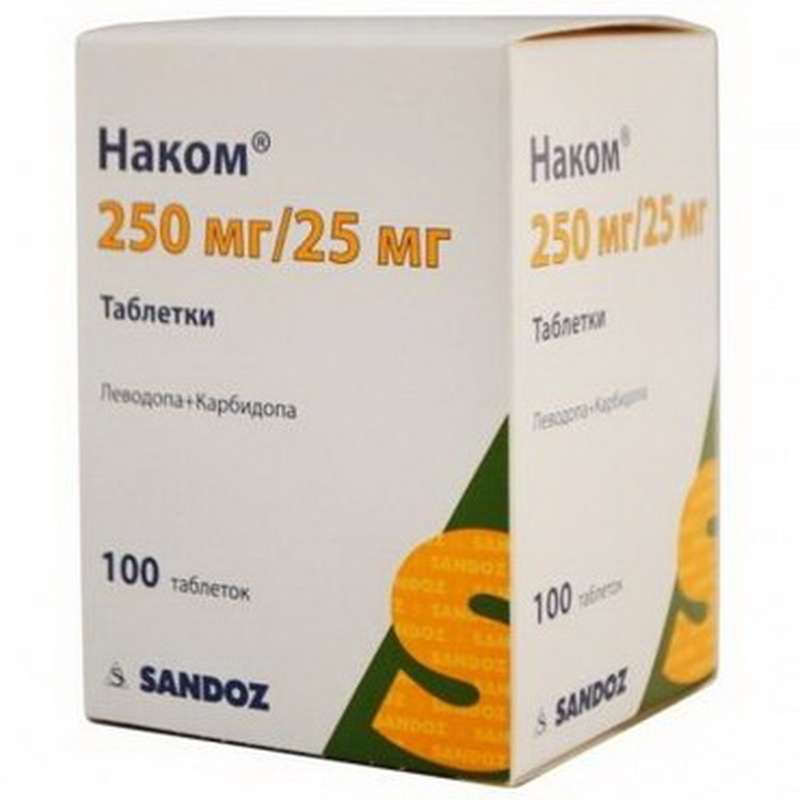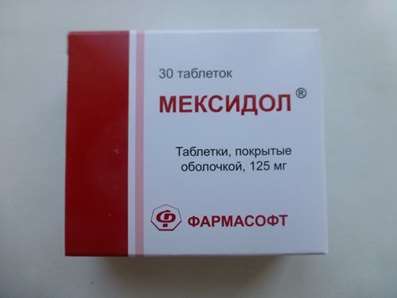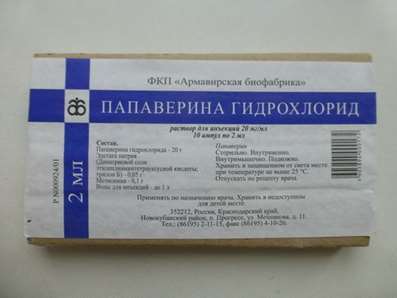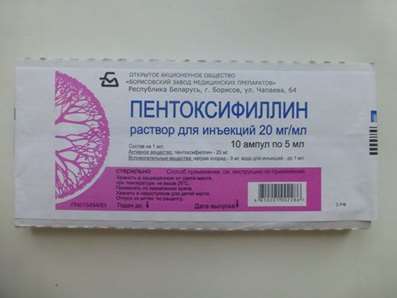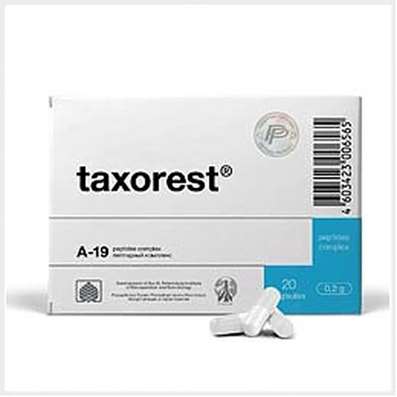Nakom is an antiparkinsonian drug.
Levodopa reduces the symptoms of Parkinson's disease by increasing the content of dopamine in the brain. Carbidopa, which does not penetrate the BBB, prevents extracerebral decarboxylation of levodopa, thereby increasing its amount entering the brain and converting to dopamine.
Nak has a more pronounced therapeutic effect than levodopa, it provides long-term maintenance of the therapeutic concentration of levodopa in plasma at doses that are approximately 80% lower than those required in the case of a single dose of levodopa.
The effect of the drug manifests itself during the first 24 hours after the start of the procedure, sometimes after the first dose. The maximum effect is achieved within 7 days.
Indications:
- Treatment of Parkinson's Disease and Parkinson's Syndrome.
Contraindications:
- an angle-closure glaucoma;
- Melanoma established or suspected;
- skin diseases of unknown etiology;
- simultaneous administration with non-selective MAO inhibitors;
- Hypersensitivity to the components of the drug.
With caution should be used in patients with severe diseases of the cardiovascular system, incl. at a myocardial infarction with infringements of a warm rhythm (in the anamnesis), at a heart failure; with severe diseases of the respiratory system, including bronchial asthma; convulsive seizures (in the anamnesis), including epileptic; with erosive-ulcerative lesions of the digestive tract (due to the possibility of bleeding from the upper gastrointestinal tract); with decompensated diseases of the endocrine system, including diabetes mellitus; with renal insufficiency of a serious degree; with severe hepatic insufficiency; with open-angle glaucoma.
Special instructions:
As with the use of levodopa, when Nakoma is prescribed to patients who underwent myocardial infarction and who have atrial, nodular or ventricular arrhythmias, a thorough preliminary examination is necessary. In such patients, it is necessary to monitor cardiac activity, especially when administering the first dose and during the dose selection period.
Patients with open-angle glaucoma NAC should be administered with caution and under the condition of constant monitoring of intraocular pressure during treatment.
Since both therapeutic and side effects are more likely to occur when using a combination of carbidopa and levodopa than one levodopa, careful monitoring is necessary during the dose selection period for patients. In particular, Nakom more often than levodopa, causes involuntary movements. The appearance of involuntary movements may require a dose reduction. An early indication of an excessive dose in some patients may be blepharospasm. If the therapeutic response to the drug levodopa is unstable, and the manifestations and symptoms of Parkinson's disease are not controlled throughout the day, then the transition to Nack usually allows you to reduce the fluctuations in the reaction to the drug.
By reducing some of the negative effects caused by levodopa, Nak provides patients with an adequate reduction in the symptoms of Parkinson's disease.
Nakom is also indicated for patients with Parkinsonism taking vitamin preparations containing pyridoxine hydrochloride (vitamin B6).
Nakom is not recommended for elimination of extrapyramidal disorders caused by medications.
In patients who have previously taken levodopa, dyskinesia can be observed, because carbidopa allows more levodopa to reach the brain, and thus, more dopamine is formed. The appearance of dyskinesia may require a dose reduction.
Like levodopa, Nakom can cause involuntary movements or mental disorders. It is assumed that these reactions are due to an increase in the content of dopamine in the brain. These phenomena may require a dose reduction. All patients taking Nakom should be supervised in connection with the possibility of developing a depressive state with suicidal tendencies. Patients who have experienced psychosis require a cautious approach when selecting therapy.
Caution should be used to appoint Nakom and psychotropic drugs. With the sudden withdrawal of antiparkinsonian drugs, a symptom complex was described that resembled a malignant neuroleptic syndrome, including muscle rigidity, fever, mental disorders, and an increase in the concentration of serum CK. Therefore, a thorough examination of patients in the period of a sharp reduction in the dose of Nakoma or its cancellation is necessary, especially if the patient receives neuroleptics. As with levodopa, during long-term treatment with Nakoma, periodic monitoring of liver, hematopoietic, cardiovascular and renal functions is recommended.
If general anesthesia is required, the Nacom product can be taken as long as the patient is allowed oral fluid and medication.
If the treatment is temporarily interrupted, then Nakoma can be resumed in the usual dose as soon as the patient is able to take the drug inside.
Use in Pediatrics
The safety of the drug in children of young and middle age is not established.
It is not recommended to appoint Nakom to children and adolescents under the age of 18 years.
Suggested Use:
The optimal daily dose is determined by careful individual selection. The shape of the tablet allows you to divide it into two parts with minimal effort.
During the treatment, it may be necessary to correct both the individually selected dose and the frequency of taking the drug. As studies have shown, peripheral dopa decarboxylase is saturated with carbidopa when the latter is administered at a dose of about 70-100 mg / day. In patients receiving carbidopa, a smaller dose may cause nausea and vomiting.
In the case of Nakoma, the administration of standard drugs for the treatment of parkinsonism, with the exception of those containing one levodopa, can be continued, with their doses to be recruited.
The initial dose is selected in accordance with the indications and response of the patient to treatment. The initial dose of Nakom is 1/2 table. 1-2 times / day. However, such a dose may not provide the optimum amount of carbidopa that the patient will need. Therefore, if necessary, add 1/2 tablet. Nakoma every day or every other day until the optimal effect is achieved. The therapeutic effect is observed on the first day, and sometimes after the first dose. The full effect is achieved within 7 days.
When switching from levodopa preparations, the administration of the latter should be stopped, at least 12 hours prior to the initiation of Nakom treatment (24 hours after the use of levodopa with prolonged action). The daily dose of Nacom should provide approximately 20% of the previous daily dose of levodopa.
For patients taking more than 1.5 g of levodopa, the initial dose of Nakoma is 1 tab. 3-4 times / day.
With maintenance therapy, if necessary, the dose of Nakoma can be increased by 1 / 2-1 tab. every day or every other day until the maximum dose is reached - 8 tablets / day. The experience of taking carbidopa in a dose of more than 200 mg / day is limited.
The maximum recommended dose of Nakom is 8 tablets / day (200 mg of carbidopa and 2 g of levodopa). This is approximately 3 mg of carbidopa and 30 mg of levodopa per 1 kg of body weight (with a patient's body weight of 70 kg).
Side effects:
From the side of the central nervous system and peripheral nervous system: most often - dyskinesia, including involuntary movements (including choreiform, dystonic); possible malignant neuroleptic syndrome, episodes of bradykinesia ("on-off" -syndrome), dizziness, drowsiness, paresthesia, episodes of psychotic conditions, including illusions, hallucinations and paranoid thinking, depression with or without suicide development, dementia, sleep disorders, agitation , confusion, increased libido.
Early signs, on the basis of which a decision can be made to abolish the drug, are muscle twitchings and blepharospasm.
In rare cases - convulsions (causal connection with the drug Nakom not established).
From the side of the digestive system: most often - nausea; possible anorexia, vomiting, bleeding from the gastrointestinal tract, exacerbation of peptic ulcer of the duodenum, diarrhea, darkening of saliva.
On the part of the body as a whole: fainting, chest pain,
From the cardiovascular system: arrhythmias and / or palpitations, orthostatic effects (including episodes of increase or decrease in blood pressure), phlebitis.
On the part of the hematopoiesis system: leukopenia, anemia (including hemolytic), thrombocytopenia, agranulocytosis.
Allergic reactions: angioedema, urticaria, pruritus, Shenlen-Henoch disease.
From the respiratory system: it is possible dyspnea.
Dermatological reactions: alopecia, skin rash, darkening of secretions of sweat glands are possible.
From the genitourinary system: darkening of urine.
Other side effects that can occur as a result of taking levodopa:
On the part of the digestive system: dyspepsia, dry mouth, bitterness in the mouth, sialorrhea, dysphagia, bruxism, bouts of hiccough, pain and discomfort in the abdomen, flatulence, burning sensation of the tongue.
From the side of metabolism: decrease or increase in body weight, swelling.
From the side of the central nervous system: weakness, fainting, fatigue, headache, asthenia, decreased mental activity, ataxia, numbness, increased tremor of hands, muscle cramps, triism, activation of latent Bernard-Horner syndrome, insomnia, anxiety, euphoria, psychomotor agitation, instability gait.
On the part of the senses: diplopia, blurred vision, dilated pupils, oculogic crises.
From the genitourinary system: delay urination, urinary incontinence, priapism.
Other: hoarseness of voice, malaise, flushes of blood to the face, neck and chest skin, dyspnoea, malignant melanoma.
On the part of laboratory indicators: increased activity of alkaline phosphatase, AST, ALT, LDH, an increase in bilirubin, urea nitrogen in plasma, an increase in serum creatinine, hyperuricemia, positive Coombs test; possible reduction of hemoglobin and hematocrit, hyperglycemia, leukocytosis, bacteriuria, erythrocyturia.
Drugs containing carbidopa and levodopa can cause a false positive reaction to ketone bodies in the urine, if test strips are used to determine ketonuria. This reaction will not change after boiling urine samples. False negative results can be obtained by using a glucose oxidase method for determining glucosuria.
Packaging:
- Comes in original packaging. Item is brand new and unopened.
Storage:
- Keep away from direct sunlight.
- Keep locked and away from children.
- Store in dry place at room temperature.
- Do not exceed storage temperature higher than 25 C
Important notice- the outer box design may vary before prior notice!

 Cart
Cart
